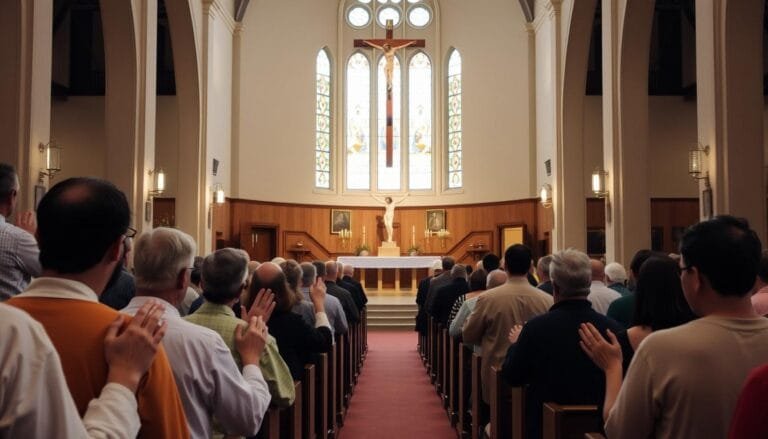Understanding God’s Mercy
This website contains affiliate links. As an Amazon Associate, I earn from qualifying purchases. The content on this website was created with the help of AI.
How can a God of perfect justice also be a God of infinite mercy? This question is at the core of Catholic teaching on divine compassion.
Scripture shows God’s mercy as His deep, lasting love. This love forgives sins, relieves suffering, and changes lives, even when we fail completely.
Take King David, known as the “man after God’s own heart,” who still sinned deeply. Yet, God declared, “The Lord has taken away your sin” (2 Samuel 12:13).
Saul, who became Paul, was completely changed by mercy, despite his past violence against Christians.
Catholic tradition says God’s mercy is not just a feeling—it’s an action. Jesus showed mercy by healing the sick, feeding the hungry, and forgiving those who repented.
His sacrifice on the cross was the ultimate act of mercy, making salvation possible through “the washing of rebirth” (Titus 3:5).
Even today, believers are urged to “be merciful, just as your Father is merciful” (Luke 6:36).
Many wonder: How do justice and mercy coexist? Can mercy ever be overextended?
This journey through Scripture and Catholic doctrine will explore these questions and show how God’s mercy connects human weakness with divine grace.
Every story, parable, and promise points to one truth: God’s mercy is as boundless as His love.
Key Takeaways
- God’s mercy is both a divine attribute and an active force in human lives.
- Scripture shows 100% forgiveness for repentant sinners through stories like David and Paul.
- Jesus’ ministry demonstrated mercy through healings, teachings, and the cross.
- Catholic teaching emphasizes mercy as central to salvation and daily faith.
- Believers are called to reflect God’s mercy in their actions and attitudes.
What Is God’s Mercy in Catholic Teaching?
At the heart of Catholic mercy teaching lies a profound truth: God’s mercy transforms how we understand His love. Let’s explore this foundational truth through three key perspectives.
The Definition and Nature of Divine Mercy
The definition of divine mercy states that God’s mercy is His choice to withhold the punishment we deserve.
The Catechism teaches that mercy flows from His infinite love. In Exodus 33:19, God declares,
“I will have mercy according to what I will have mercy.”
This reflects His boundless compassion, even when we fail. Imagine a debt of $8.6 billion erased—not because we earned it, but because He chooses to forgive.
Distinguishing Mercy from Justice and Grace
Understanding mercy vs justice clarifies God’s holiness. Mercy lets go what we deserve; justice ensures fairness. Grace, like mercy vs grace, gives what we don’t earn. Compare them:
| Concept | Description |
|---|---|
| Mercy | Withholds punishment owed |
| Justice | Gives what is deserved |
| Grace | Gives what is undeserved |
Jesus’ parable of the unforgiving servant shows this: the $8,000 debt pales next to the $8.6B debt forgiven. Mercy triumphs over legalistic demands.
The Primacy of Mercy in Catholic Theology
Pope St. John Paul II’s encyclical Dives in Misericordia calls mercy the “heart of the Gospel.” We experience mercy through the Sacrament of Reconciliation.
Mercy isn’t a side teaching—it’s the path to salvation. As we pray the Divine Mercy Chaplet, we embrace this truth: God’s mercy is our greatest hope.
Biblical Foundations of God’s Mercy
God’s mercy is all over Scripture, showing us His kindness even when we mess up. Bible verses about mercy start in the Old Testament.
There, Yahweh says, “The Lord, the Lord, a God merciful and gracious, slow to anger, and abounding in steadfast love and faithfulness” (Exodus 34:6 NABRE).
This proclamation sets the stage for Old Testament mercy. It shows God’s mercy even when the Israelites made mistakes, like worshiping the golden calf.
This pattern of mercy in Scripture continues through David’s repentance and the psalms’ pleas for forgiveness.
Jesus takes this even further, showing us what Jesus and mercy mean. Like the Prodigal Son, his stories show mercy as a father’s endless love.
His sacrifice on the cross is the ultimate act of mercy, bringing us back to the Father. These stories tell us mercy is more than a word—it’s God’s constant love for us.
As we read Scripture, let’s learn to show His mercy to others today.
The Divine Mercy Devotion and St. Faustina
At the heart of the Divine Mercy devotion is St. Faustina Kowalsska, a humble nun whose visions changed modern Catholic spirituality. In 1931, she was called to share Christ’s mercy.
The devotion invites all to experience mercy through prayer and sacraments.
Anna Kowalsska, known as St. Faustina, lived simply despite her little formal education. She was born in 1905 and joined the Sisters of Our Lady of Mercy in 1925.
Jesus gave her the Divine Mercy Image and chaplet through visions.
She passed away in 1938, but her legacy lives on. Pope St. John Paul II canonized her in 2000, calling her the “Apostle of Divine Mercy.”
In 1931, Jesus appeared to Faustina in a pale and red light. These rays symbolized the waters and blood of His Passion. He told her:
“Paint an image according to the pattern you see, with the two rays issuing from the heart.”
The words “JESUS, I TRUST IN YOU” frame the image, inviting trust in divine love.
Praying the Divine Mercy Chaplet
St. Faustina’s writings guide the chaplet, blending Scripture and Eucharistic devotion. Here’s how to pray it:
- On the large beads: Say the Eternal Father prayer once, followed by three “Holy God…” lines at the end.
- On the small beads: Repeat “For the sake of His sorrowful Passion…”
Prayed daily or during the Divine Mercy Novena, the chaplet offers hope for souls. The Novena’s nine days focus on specific intentions:
| Day | Intention |
|---|---|
| 1 | All mankind, specially sinners |
| 2 | Souls of priests and religious |
| 3 | Devout and faithful souls |
| 4 | Non-believers and those distant from Christ |
| 5 | Souls of separated brethren |
| 6 | Souls who venerate mercy |
| 7 | Souls in purgatory |
| 8 | Lukewarm souls |
The Divine Mercy Sunday Celebration
Each year, the Sunday after Easter is a day of grace. Jesus promised: “Souls who receive sacraments on this day gain full forgiveness.”
Pope St. John Paul II instituted the feast in 2000, uniting the Church in mercy. The 3 p.m. hour—when Christ died—remains a time of special grace.
It urges us to pray for souls and receive mercy’s embrace.
Pope Francis and the Message of God’s Mercy
Since 2013, Pope Francis has made mercy central to his teachings. He encourages believers to live with mercy at the heart of their faith.
During the Year of Mercy (2015–2016), he invited Catholics to experience God’s compassion through sacraments and service.
This effort turned parishes into places of reconciliation, highlighting mercy in today’s Catholic life.

The Year of Mercy and Its Impact
Pope Francis opened the Holy Door in St. Peter’s Basilica to start the Year of Mercy. He said mercy connects God and man.
Over 1.5 million people visited Rome, and local churches hosted mercy pilgrimages and communal confessions.
This event left a lasting impact, showing mercy as a living reality, not just a historical event.
Mercy is not a weakness—it’s the strength to forgive and heal.
Key Teachings from Misericordiae Vultus
In Misericordiae Vultus, Pope Francis states that mercy is the Church’s mission. He calls us to spread Christ’s mercy worldwide, emphasizing compassion over strict rules.
His teachings emphasize mercy as an action, not just a feeling. Even today, his vision is reshaping how we practice our faith, including parish outreach programs.
Living Mercy in Modern Times
- Visit the sick: Pope Francis says this act mirrors Jesus’ healing ministry.
- Offer forgiveness daily: As he teaches, holding grudges blocks God’s mercy in our lives.
- Advocate for marginalized groups: His vision of the Church as a “field hospital” means prioritizing the hurting.
His coat of arms shows the motto “Miserando atque Eligendo”—“By having mercy, he chose us.” This motto inspires us to live mercifully through small acts of kindness.
When we confess sins or share meals with the lonely, we join in Christ’s mercy. Let’s follow his call: “Be close to the people Jesus loved most.”
The Sacraments as Channels of God’s Mercy
God’s mercy flows to us through the sacraments, Christ’s chosen means of healing and transformation.
The sacraments of mercy—like Reconciliation—are not just rituals. They are living encounters with divine love.
When we confess sins, we step into the mercy of a Father who “saved us through the washing of rebirth” (Titus 3:5).
The sacrament of Reconciliation reminds us that no sin is beyond forgiveness with sincere repentance.
At the heart of our faith, the Eucharist and mercy intertwine. Every Mass renews our participation in Christ’s sacrifice.
Mercy meets us in the form of bread and wine. By receiving the Eucharist worthily, we become living vessels of that same mercy to others. Consider these channels of grace:
- Reconciliation: Restores peace through forgiveness
- Eucharist: Strengthens us to live mercifully
- Anointing of the Sick: Brings healing for body and soul
The Anointing of the Sick is a sacrament of solidarity. When we or our loved ones suffer, it reminds us that Christ walks with us in pain.
Even in weakness, God’s mercy becomes most visible. The Church’s tradition calls us to receive these sacraments not just occasionally but as part of a living relationship with Christ.
Let us approach the sacraments not with fear but with childlike trust. Through them, mercy becomes a daily reality.
It shapes families and individuals into instruments of God’s love in the world.
| Sacrament | How Mercy Works |
|---|---|
| Reconciliation | Washes away sin, restoring communion with God |
| Eucharist | Nourishes souls with Christ’s sacrificial love |
| Anointing of the Sick | Brings comfort and hope in suffering |
Practical Ways to Experience and Share God’s Mercy
Starting to live mercifully means taking action. The Bible says, “Be merciful, just as your Father is merciful” (Luke 6:36). Here are simple ways to show God’s love daily.
“Blessed are the merciful, for they shall obtain mercy.” — Matthew 5:7
Corporal Works of Mercy: Serving With Hands and Hearts

These seven acts help meet physical needs, turning faith into action:
- Feed the hungry: Organize a pantry drive or share a meal with someone alone.
- Shelter the homeless: Support housing policies or stay at a shelter.
- Clothe the naked: Donate clothes or help with a community swap.
Spiritual Works of Mercy: Healing Invisible Wounds
These seven acts care for souls, not just bodies:
- Visit the sick: Send a note or pray for their healing.
- Comfort the imprisoned: Write a letter or volunteer in outreach.
- Bury the dead: Help families plan memorials with respect.
Building a Relationship Through Mercy
Grow closer to Christ by:
Pray daily with verses like Micah 6:8, encouraging us to act justly and show compassion. Reflect on the Sorrowful Mysteries of the Rosary to understand Jesus’s love.
Write down three merciful acts each week—small steps become habits.
God’s mercy is a circle: as we do corporal works and spiritual works, we reflect His grace.
Every choice to serve, forgive, or comfort another is a step toward living mercifully with joy and purpose.
Common Misconceptions About God’s Mercy
Many think God’s mercy lets us sin freely or is passive. But mercy actually demands change. Let’s clear up these ideas to draw closer to Christ.
Mercy vs. Permissiveness
God’s mercy isn’t “cheap grace” that overlooks sin. Divine mercy limits are there to help us grow, not to enable sin. True mercy pushes us to change, not to stay the same.
The Bible says, “Shall we sin so that grace may abound? By no means!” (Romans 6:1-2). Practicing lectio divina helps us understand this better.
Is God’s Mercy Unconditional?
God’s mercy is always ready, but we must respond. The story of the Prodigal Son shows mercy’s power, but it needs our effort to seek forgiveness.
Mercy and sin face us daily, but grace meets us where we are. “Turn to Me and be saved, all the ends of the earth!” (Isaiah 45:22).
Mercy and Sin: A Balanced Truth
Church teachings balance mercy with sin’s consequences. Divine mercy doesn’t excuse sin but calls for change.
Pope Francis says, “Mercy without truth is sentimentalism; truth without mercy is tyranny.” Sacraments like Confession show us how to find healing through mercy.
“Your mercy, O Lord, reaches to the heavens” (Psalm 36:5-6).
God’s mercy changes us when we face sin honestly. Like the Israelites, we can repent and find new life through His grace.
Conclusion: Embracing the Transformative Power of Divine Mercy
Transformation starts when we see God’s endless love always with us. Every tough time, hurt, and doubt is a chance for His mercy to work.
The Catholic journey of mercy is found in sacraments and simple prayers. Divine Mercy Sunday celebrates Jesus’s sacrifice for us.
I remember His final hours by praying the Chaplet at 3:00 PM each day. The image’s red and white rays show His cleansing grace.
Trust in divine mercy means believing no sin is too big for Him—neither ours nor others’. Saint Faustina saw God’s mercy as a deep sea, ready to fill our hearts with courage.
Matthew 5:7 tells us to be merciful like God. This year, think about joining special services or saying the Chaplet.
The Catholic Daily Prayer Book can help you live mercy every day. Romans 9:15-16 reminds us that salvation is a gift from God, not our doing.
Start today by saying “Jesus, I trust in You” when faced with challenges. Spread mercy’s light with a smile, a kind word, or a silent prayer.
As God’s people, we are called to show mercy’s power. Let your journey of mercy change not just your soul but the world.








